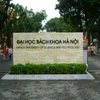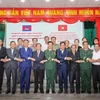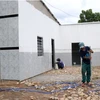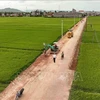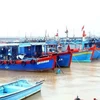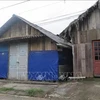Ho Chi Minh City has been mobilising funds for 20 transport works since the beginning of the year to ensure faster completion of the projects, with the aim of easing traffic congestion.
Since early 2014, the Transport Department has placed priority for capital on unfinished projects to avoid losing time and money. As capital for infrastructure has sharply fallen, the city has had to focus on the most important construction works.
Hanoi Highway is the main road for the eastern gateway of the city, but traffic jams have often occurred there, especially near Suoi Tien Tourism Park. During holidays and festivals, it often took three to four hours to escape from the traffic congestion.
However, since the HCM City – Long Thanh – Dau Giay highway now can take 14,000 – 16,000 cars and buses each day, transport on the Hanoi Highway has significantly improved.
The new highway has shortened the distance from HCM City to Long Thanh district in Dong Nai province from 45 km (60 minutes), to 22 km (20 minutes).
Downtown, three fly-over bridges in districts 10, 11 and Tan Binh at a cost of over 1 trillion VND (50 million USD) have been completed and have helped to reduced traffic jams, even during rush hours.
The route Tan Son Nhat – Binh Loi – Pham Van Dong has become the largest downtown road, with six- to 12-car lanes and a length of 13.7 km.
The route cost 340 million USD and was built by the Republic of Korea’s GS Group under the build-transfer (BT) model.
According to an estimate from the municipal Transport Department, around 40 percent of means of transport from the neighbouring province of Binh Duong travels into HCM City through this route.
It has helped to reduce traffic pressure on National Road No 13, which links Binh Duong province with HCM City via Binh Thanh district.
The second phase of the route will be finished by the end of this year. It extends from Binh Trieu to Linh Xuan intersection in Thu Duc district.
When the route is completed, it will closely link HCM City with the two neighbouring provinces of Dong Nai and Binh Duong.
In order to reduce traffic overload and limit accidents, the city wants to invest in a completed belt road from Phu My Bridge in District 7 to Rach Chiec Bridge in District 9 at a length of 9.4 km and width of 67m with seven new bridges.
The belt road is expected to create more favourable conditions for transport into Cat Lai port as heavy trucks will be able to use the road.
Two other important projects at the western gateway of the city are provincial road No 10 and No 10B, which will be completed later this year after a delay of several years.
Expansion for provincial road No 10 from the Tan Tao Bridge in Binh Chanh district to Xang Bridge, next to Long An province, with a length of 8 km, began in late 2008. Due to delayed ground clearance, the project has not been completed.
A similar situation has occurred to Provincial Road No 10B, 6km long, from Ten Lua Road in Binh Tan district. It links with Provincial Road No 10.
The road will link HCM City with Long An and other Mekong Delta provinces as well as connect to industrial parks in Duc Hoa and Duc Hue districts in Long An province to the city's Le Minh Xuan and Tan Tao industrial parks.
The municipal Transport Department has said that these two projects were important and have received a great deal of capital as well as ground compensation. The target is completion at the end of this year.
Provincial roads No 10 and 10B are expected to reduce traffic pressure on National Highway No 1A through Binh Chanh district and shorten the time to transport commodities between industrial parks in HCM City and Long An province.
Though some construction works are small, they are very important. For example, the 700m long Thanh Da Bridge will be the only way for all of the residents on the Thanh Da peninsula to connect to other places.
Another smaller but important project is the intersection before National University in HCM City. The work is 1.8 km long, extending from the gate of the Suoi Tien Tourism Park to Dong Nai Bridge.-VNA
Since early 2014, the Transport Department has placed priority for capital on unfinished projects to avoid losing time and money. As capital for infrastructure has sharply fallen, the city has had to focus on the most important construction works.
Hanoi Highway is the main road for the eastern gateway of the city, but traffic jams have often occurred there, especially near Suoi Tien Tourism Park. During holidays and festivals, it often took three to four hours to escape from the traffic congestion.
However, since the HCM City – Long Thanh – Dau Giay highway now can take 14,000 – 16,000 cars and buses each day, transport on the Hanoi Highway has significantly improved.
The new highway has shortened the distance from HCM City to Long Thanh district in Dong Nai province from 45 km (60 minutes), to 22 km (20 minutes).
Downtown, three fly-over bridges in districts 10, 11 and Tan Binh at a cost of over 1 trillion VND (50 million USD) have been completed and have helped to reduced traffic jams, even during rush hours.
The route Tan Son Nhat – Binh Loi – Pham Van Dong has become the largest downtown road, with six- to 12-car lanes and a length of 13.7 km.
The route cost 340 million USD and was built by the Republic of Korea’s GS Group under the build-transfer (BT) model.
According to an estimate from the municipal Transport Department, around 40 percent of means of transport from the neighbouring province of Binh Duong travels into HCM City through this route.
It has helped to reduce traffic pressure on National Road No 13, which links Binh Duong province with HCM City via Binh Thanh district.
The second phase of the route will be finished by the end of this year. It extends from Binh Trieu to Linh Xuan intersection in Thu Duc district.
When the route is completed, it will closely link HCM City with the two neighbouring provinces of Dong Nai and Binh Duong.
In order to reduce traffic overload and limit accidents, the city wants to invest in a completed belt road from Phu My Bridge in District 7 to Rach Chiec Bridge in District 9 at a length of 9.4 km and width of 67m with seven new bridges.
The belt road is expected to create more favourable conditions for transport into Cat Lai port as heavy trucks will be able to use the road.
Two other important projects at the western gateway of the city are provincial road No 10 and No 10B, which will be completed later this year after a delay of several years.
Expansion for provincial road No 10 from the Tan Tao Bridge in Binh Chanh district to Xang Bridge, next to Long An province, with a length of 8 km, began in late 2008. Due to delayed ground clearance, the project has not been completed.
A similar situation has occurred to Provincial Road No 10B, 6km long, from Ten Lua Road in Binh Tan district. It links with Provincial Road No 10.
The road will link HCM City with Long An and other Mekong Delta provinces as well as connect to industrial parks in Duc Hoa and Duc Hue districts in Long An province to the city's Le Minh Xuan and Tan Tao industrial parks.
The municipal Transport Department has said that these two projects were important and have received a great deal of capital as well as ground compensation. The target is completion at the end of this year.
Provincial roads No 10 and 10B are expected to reduce traffic pressure on National Highway No 1A through Binh Chanh district and shorten the time to transport commodities between industrial parks in HCM City and Long An province.
Though some construction works are small, they are very important. For example, the 700m long Thanh Da Bridge will be the only way for all of the residents on the Thanh Da peninsula to connect to other places.
Another smaller but important project is the intersection before National University in HCM City. The work is 1.8 km long, extending from the gate of the Suoi Tien Tourism Park to Dong Nai Bridge.-VNA
